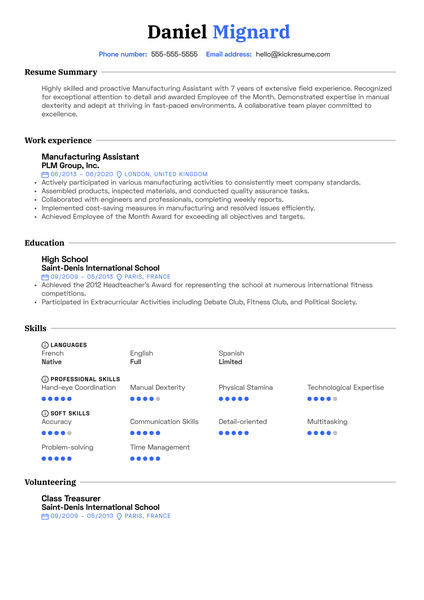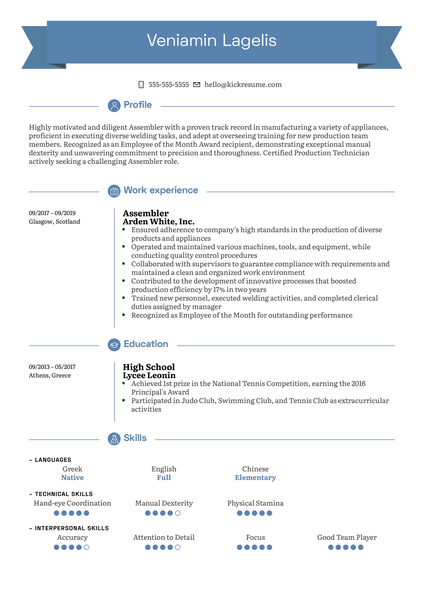5 steps for writing an effective welder resume
Welders are essential for the creation and repair of metal goods. Without experienced and professional welders around, our cities and towns would lack critical components to their infrastructure and industrial systems. As a result, employers seek out motivated welders with a high level of adaptability and willingness to learn.
In this guide, we will cover everything you need to know about writing a resume as a welder. Keep reading to learn how to:
- Select a reverse-chronological format to showcase your experience
- Create a resume summary that highlights your specializations and accomplishments
- Include soft skills along with hard skills on your welder resume
- Write a welder work experience section tailored for the job
- List your education and certifications correctly as a welder
Still looking for a job? These 100+ resources will tell you everything you need to get hired fast.
1. Select a reverse-chronological format to showcase your experience
As a welder, you want to emphasize your formal work experience whenever possible on your resume.
To do this, your best formatting option is the reverse-chronological resume. This resume format focuses almost entirely on work experience, making it the largest and most prominent section on the document. Within this section, you will detail your most recent job first and work backward from there.
Reverse-chronological resumes work wonders for applicants with enough experience to fill them out fully – but what about those applicants with limited experience?
There are two main alternatives to the RC resume:
- Functional Resume: The functional resume focuses on education and skills instead of experience. This format is well-suited for applicants who have recently graduated high school or college and who do not yet have an extensive work history.
- Hybrid Resume: The hybrid resume combines elements of both the functional and reverse-chronological formats, placing more equal emphasis amongst all sections. This format works well for candidates with limited work experience, those who switching careers, or those who have large gaps in their employment history.
Choose your preferred template and make your resume shine.
2. Create a welder resume summary that highlights your specializations and accomplishments
A resume summary is a brief statement that starts off your resume. This summary is often used as an introduction of the applicant to employers, helping to establish them as qualified and driven professionals.
For welders, the resume summary offers a great opportunity to highlight your best strengths, specializations, and any key accomplishments from your time in previous positions.
Below we have provided an example of a weak welder resume summary, followed by a corrected example and explanation.
Incorrect welder professional summary example
Experienced Welder with over 10 years working in the field. Well-versed in a variety of welding techniques and working with many different types of materials. Recipient of a county-wide customer service award recognizing exemplary service.
Why is this Incorrect?
Whenever you write a resume summary, you should aim to be as specific as possible. Remember – this summary will help to introduce you, as an applicant, to the employer. You want to include specific details that help your resume summary become more engaging and interesting, compelling employers to read onwards.
Corrected welder professional summary example
Motivated Welder with 10+ years of experience utilizing a full range of welding techniques. Specialized in the use of steel, copper, cast iron, and aluminum. Recipient of the Most Reliable Welder of 2020 award, given by the Buncombe County Chamber of Commerce.
Why is this Correct?
In this corrected example, the applicant offers a much higher level of detail, including the exact name of the award they earned and what types of metals they are specialized in working with. This makes the summary much stronger, with more active language and intention bolstering the strength of the words.
3. Include soft skills along with hard skills on your welder resume
When working as a welder, it can be easy to focus too much on your technical abilities and neglect your interpersonal abilities as a result.
On a resume, employers expect to see both hard and soft skills. Hard skills refer to the technical abilities a person possesses that must be earned through education and training. Soft skills, by comparison, are the interpersonal abilities that define how easy and professional a person is to work with. While soft skills can be learned and improved, they also tend to be inherent qualities of a person as well.
To help you brainstorm ideas for both hard and soft skills to include on your resume, here are 10 examples of both to get you started:
The best hard skills to put on your welder resume
- Metal fabrication
- Reviewing blueprints
- Calculating dimensions
- Project planning and panagement
- Manufacturing metal structures, tools, and equipment
- Specializations in specific saterials (steel, copper, etc.)
- Basic mathematical skills
- 2-D and 3-D diagrams
- Identifying joints
- Cutting and trimming metal
Effective welder soft skills for your CV
- Exceptional attention to detail
- Verbal and non-verbal communication
- Teamwork and collaboration
- Spatial reasoning
- Hand-eye coordination
- Organization
- Reliability
- Time management
- Independent working
- Visualization
4. Write a welder work experience section tailored for the job
Your work experience section should not only showcase your key responsibilities and accomplishments from a previous job. It should also help reflect the desired skills and experience the employer is asking for, establishing you as a highly qualified candidate for the position.
As you write your work experience section, consider what specific details you can include that make you a more competitive candidate, such as statistics or improvements to a company that you directly helped achieve.
Here is an example of a work experience entry from a welder resume
Beacon Welding Co., Salem, MA
Journeyman Welder
June 2017 to November 2019
- Accurately interpreted diagrams, sketches, and blueprints to determine and obtain the best materials and design plans for a given job.
- Implemented new onsite safety standards that helped to reduce at-work injuries by 15%.
- Operated, monitored, and maintained a variety of welding machines and metalworking equipment.
5. List your education and certifications correctly as a welder
There is no singular pathway to becoming a welder. For applicants who are recent graduates of high school, there may have been in-school opportunities to learn the craft of welding and become certified.
For other older applicants, earning a career in welding can be achieved via vocational school, community college, or certified training programs.
No matter what your level of education is, make sure to include the following details on your resume:
- Your highest level of education (high school diploma, GED, Bachelor’s Degree, etc.)
- The school or university you attended
- Your date of graduation
As for certifications, you should always include at minimum the formal name of the certificate earned and the certifying institution. If the certification has an expiration date, include this information as well.
Here is an example of a well-crafted education section on a welder resume
Education
Central Carolina Community College
Associates Degree in Welding Technology
- Graduated: 2018
- GPA: 6
Certifications
- Safety in Welding Certificate — Central Carolina Community College
- Certified Welding Fabricator — American Welding Society






![How to Write a Professional Resume Summary? [+Examples]](https://d2xe0iugdha6pz.cloudfront.net/article-small-images/i-Profile.svg)
![How to Put Your Education on a Resume? [+Examples]](https://d2xe0iugdha6pz.cloudfront.net/article-small-images/i-Collage-Universities.svg)
![How to Describe Your Work Experience on a Resume? [+Examples]](https://d2xe0iugdha6pz.cloudfront.net/article-small-images/Experience.svg)


